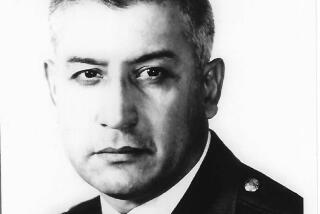Scrapbooks of War-Era Sweethearts Preserve ‘Memphis Belle’ Fairy Tale : History: The young pilot put his sweetheart’s likeness on the nose of a famous WWII bomber. Their romance died in the glare of a war bond tour.
MEMPHIS, Tenn. — It was one of the most public romances of World War II, a fairy tale story of a brave, young bomber pilot and the Memphis belle who won his heart.
“I’ll return to make you happy forever,” the pilot wrote between bombing missions over German-occupied Europe.
He survived the war, but the fairy tale didn’t. The romance died amid the glare of a public relations campaign cranked up to sell war bonds.
Now all that is left are three crumbling scrapbooks stuffed with love letters and news clippings, crushed flowers and an aging “Do Not Disturb” sign for a hotel room door.
The story of love and heartbreak are told in the mementos of Margaret Polk, whose leggy likeness graced the nose of one of America’s most famous bombers, the Memphis Belle, the B-17 that pilot Robert Morgan named for his sweetheart.
Polk died last year at age 67 and left her scrapbooks to Memphis State University.
“She was a young girl of 19 and she put everything in the scrapbooks,” said Michelle Fagan, a library curator at the university.
Morgan and his crew took the Belle on a nationwide bond-selling tour, and the plane was featured in a wartime documentary by filmmaker William Wyler. A commercial movie named “Memphis Belle”--co-produced by Wyler’s daughter, Catherine--was released last year by Warner Bros.
The returning warriors, fresh from the horrors and loneliness of war, drew crowds of admiring young women.
Morgan and Polk planned to marry after the war, sending War Department publicists into high gear. They never explained the breakup, but both blamed the strain of the tour and the public spotlight.
“I am made a hero when all I want is you,” Morgan wrote while trying to rekindle the affair.
Polk said in an interview with a university researcher that she called Morgan on the tour and a woman she didn’t know answered the phone in his hotel room.
“Something went on that I didn’t particularly like . . . and that was it,” she said.
“We all make mistakes,” Morgan wrote in one of the letters dating from the late 1940s, several years after the breakup. “I have forgiven people. Can’t you?”
They met in Walla Walla, Wash., in 1942 while Polk was on vacation and Morgan was in flight training.
Morgan, who left the Army as a major, married twice and fathered four children. Polk married briefly in the 1950s but resumed her maiden name and lived most of her life single in Memphis.
Her mementos are devoted almost entirely to her romance with Morgan.
She waged a lifelong battle with alcoholism and began working in the 1960s as a volunteer with Alcoholics Anonymous.
“The idea is to give of yourself, which creates a void in yourself and makes room for goodness to come in,” she said in an interview three years ago.
Polk and Morgan took part in dedication ceremonies in 1987 for the Memphis Belle, which is on display at a park beside the Mississippi River.
“We remained friends right up until the time she died,” Morgan, 71, said from his home in Asheville, N. C. “My wife and I went over and stayed with her several times in her home.”
Polk was supported by an inheritance and spent much time with her pet dogs and gardening.
“I think I love dogs so much because I don’t trust human nature,” she once said. “It can fool you.”
The scrapbooks will be on display when preservation work is finished.
“Capt. Morgan wrote a fine love letter, no two ways about it,” said Fagan, the curator. “It makes it quite obvious from the way he could express himself how he was able to sweep Margaret Polk off her feet.”
Many of the letters were written just before or after bombing runs.
“Bad day, never forget it. Huns won’t either,” he wrote after one raid. “No denying I was scared to death. It was one real nightmare. But I know you are flying with me.”
More to Read
Sign up for our Book Club newsletter
Get the latest news, events and more from the Los Angeles Times Book Club, and help us get L.A. reading and talking.
You may occasionally receive promotional content from the Los Angeles Times.







